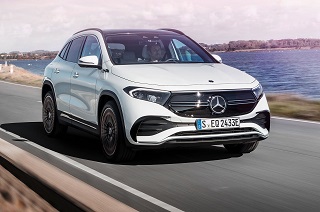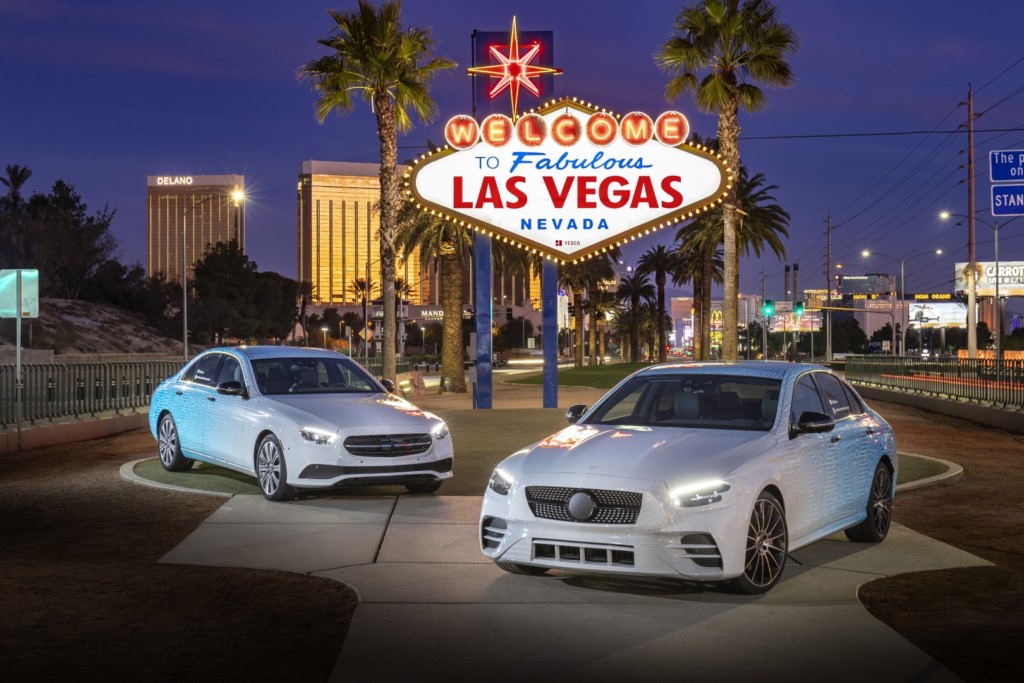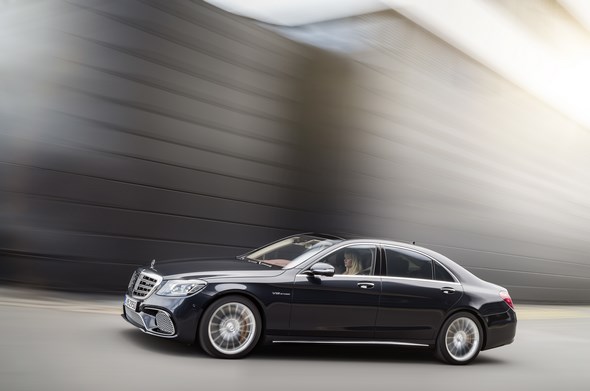Strategic hybrid initiative from Mercedes-Benz

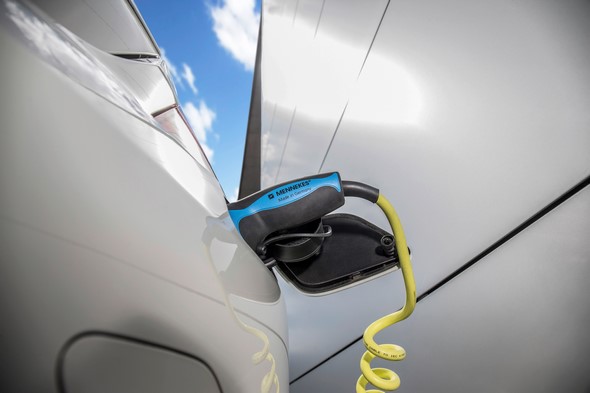
Ten new plug-in hybrids by 2017
Stuttgart/San Francisco. Extra impetus for the Mercedes-Benz strategic hybrid initiative: In the run-up to 2017 the company is bringing out a total of ten plug-in hybrid models, i.e. one new model with high-tech hybrid drive every four months on average.
Following the successful launch of the S 500 PLUG-IN HYBRID, this month will see the C 350 e, the second model to feature the progressive drive concept, find its way to dealerships.
And what might happen next with the strategic hybrid initiative has just been demonstrated by the Concept V-ision e study at the Geneva Motor Show. Under the new Mercedes-Benz nomenclature, an “e” replaces the words PLUG-IN HYBRID.
“Plug-in hybrids are a key technology on the road to the local emission-free future of the automobile,” emphasises Prof Dr Thomas Weber, member of the Board of Management of Daimler AG and responsible for Group Research and Mercedes-Benz Cars Development.
“Plug-in hybrids offer our customers the best of both worlds; in the city they can drive in all-electric mode, while on long journeys they benefit from the combustion engine’s range.
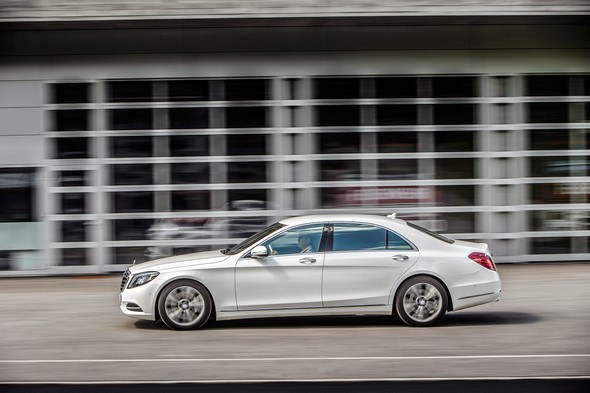
In addition, hybridisation makes the combustion engine more efficient and brings with it a special type of dynamic performance – making driving an absolute pleasure.”
As the plug-in hybrid comes into its own especially in larger vehicles and with mixed distance profiles, Mercedes-Benz is opting for this drive concept from the C-Class upwards, which means that this key technology will make its entry soon into the SUV segment with the new Mercedes-Benz GLE.
With plug-in hybrids, Mercedes-Benz Cars is stepping up its drive to reduce CO2 emissions: at 129 g/km, the European fleet value for 2014 was once again 5 g lower than the year before.
This is equivalent to an average consumption of 5.1 litres/100 km. This means that the company has lowered the CO2 emissions of its fleet in Europe by over 40 percent within two vehicle generations.
The strategic hybrid initiative is decisively facilitated by Mercedes-Benz’s intelligent modular hybrid concept, which is scalable to allow it to be transferred to a large number of model series and body versions as well as left and right-hand drive variants.
Concept V-ision e: feel-good atmosphere with modern loft character
With the Concept V-ision e, Mercedes-Benz has just given a preview at the Geneva Motor Show of the versatile development potential of the V-Class, a further model series that enjoys powerful propulsion thanks to modular plug-in hybrid technology.
The highly efficient twin power source of petrol engine and electric motor delivers a system output of 245 kW (333 hp) with a system torque of up to 600 Nm.
This guarantees sporty performance – with a standard consumption of less than 3.0 litres of fuel per 100 kilometres.
An all-electric range of up to 50 kilometres turns day-to-day short-distance driving into an enjoyable local emission-free experience.
In the interior, the Concept V-ision e offers a unique feel-good atmosphere with a modern loft character.
The largest panoramic glass sunroof in the mid-size van segment ensures an extensive light-flooded space which, in combination with bright, white trim and a brown real-wood floor, conveys a previously unknown feeling of expanse, freedom and airiness.
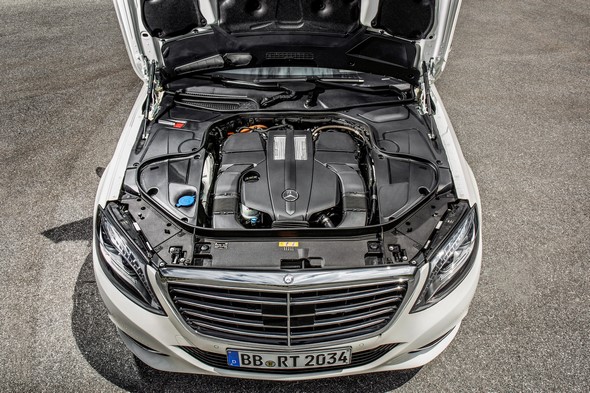
Numerous additional new comfort features, such as executive seats with calf support, massage function and footrest in the rear or a large centre console with heated cup holders and five-litre refrigerator box, provide further scope for individualisation of the V-Class.
C 350 e: available as saloon or estate
The first model to sport the new “e”, the new Mercedes-Benz C 350 e is a plug-in hybrid that combines extraordinary levels of efficiency, dynamism and comfort.
In either the saloon or estate variant, the performance of a sports car makes it a convincing proposition, especially in combination with a certified consumption of just 2.1 litres of fuel per 100 kilometres and an all-electric range of up to 31 kilometres.
Its four-cylinder petrol engine, in conjunction with a powerful electric motor, gives it a total system output of 205 kW (279 hp) with a system torque of 600 Nm.
Both the saloon and the estate model are equipped with air suspension and a pre-entry climate control system as standard, delivering a unique level of driving and climate comfort.
The price of the C 350 e starts at 50,961.75 euros (Saloon) or 52,627.75 euros[1] (Estate). Both vehicles are at dealerships from March 2015.
S 500 PLUG-IN HYBRID: luxury saloon with exceptional efficiency
The S 500 PLUG-IN HYBRID blends an ultramodern hybrid drive configuration with the unique innovations and luxurious equipment and appointments of the S-Class.
This long-wheelbase luxury saloon impresses with its exceptional dynamism and efficiency. Thanks to the standard-specification pre-entry climate control system it also offers outstanding climate comfort.
With a system output of 325 kW and 650 Nm of torque, the Mercedes-Benz S 500 PLUG-IN HYBRID accelerates from 0 to 100 km/h in 5.2 seconds while boasting an all-electric range of up to 33 km.
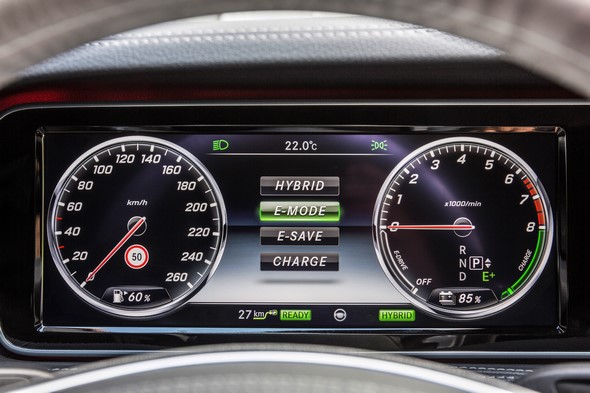
The certified consumption is 2.8 litres/100 km, which is equivalent to emissions of 65 g CO2/km. The Mercedes-Benz S 500 PLUG-IN HYBRID is available from a price of 108,944.50 euros.
Environmental certificate: environmentally exemplary over the entire
life cycle
Like all Mercedes-Benz vehicles, the hybrid models of the C and S-Class come with environmental certificates.
These document the models’ environmental performance from development through to recycling, across the entire life cycle, and the performance is certified to internationally recognised standards by independent experts.
With regard to CO2 emissions, the certificate attests the following for the C 350 e: “Over the entire life cycle, comprising manufacture, use over 200,000 kilometres and recycling, there are clear advantages compared with the C 250.
External charging with the European electricity mix can cut CO2 emissions by around 29 percent (9.6 tonnes) compared with the C 250 petrol-engined model.
The use of renewably generated hydroelectricity allows a 41 percent reduction (15.1 tonnes).”
Extensive know-how in the field of hybrid and electric vehicles
In 1982, at the same time as it was launching the Mercedes-Benz 190, the predecessor of the C-Class, Mercedes-Benz also presented the first concept vehicle with a hybrid drive in which the battery was charged by a two-cylinder horizontally opposed engine.
A number of other experimental vehicles followed until in 2009 the world’s first standard-specification hybrid drive with lithium-ion battery made its debut at Mercedes-Benz: for a long time, this S 400 HYBRID was the most fuel-efficient petrol-engined luxury saloon and the most successful hybrid in its segment.
The second-generation hybrid transmission evolved on the basis of the 7G-TRONIC PLUS automatic transmission.
It premiered in 2012 in the E 300 BlueTEC HYBRID, the first diesel hybrid in the premium segment worldwide.
By combining the efficiency of a diesel engine with the advantages of the hybrid drive, Mercedes-Benz set another milestone in the development of the automobile and advanced into consumption regions of 4 litres of diesel per 100 km in the luxury saloon segment.
After the E 300 BlueTEC HYBRID, S 400 HYBRID, S 300 BlueTEC HYBRID, C 300 BlueTEC HYBRID and S 500 PLUG-IN HYBRID, the C 350 e is the latest hybrid model from Mercedes Benz.
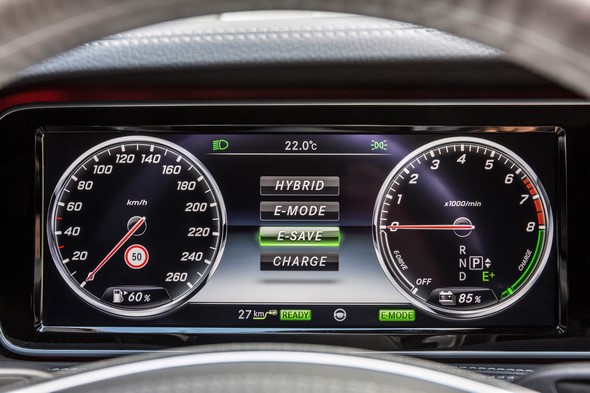
In the years to come, the main emphasis as regards alternative drives will be on PLUG-IN HYBRIDS. The company is also a leading player in the field of all-electric mobility.
Growing range: all current hybrid and electric drive vehicles from Mercedes-Benz Cars:
- 2012: smart fortwo electric drive
- 2012: E 300 BlueTEC HYBRID
- 2013: SLS AMG Coupé Electric Drive
- 2013: S 400 HYBRID
- 2013: S 300 BlueTEC HYBRID
- 2014: C 300 BlueTEC HYBRID
- 2014: B-Class Electric Drive
- 2014: S 500 PLUG-IN HYBRID
2015: C 350 e
[1] All prices: sales prices in Germany, incl. 19 percent VAT
The new Mercedes-Benz C 350 e
Efficiency, dynamism and comfort – the best of three worlds
Following its premiere in the S-Class, Mercedes-Benz is now offering its most advanced hybrid technology yet in the C-Class and, for the first time, also in an estate model.
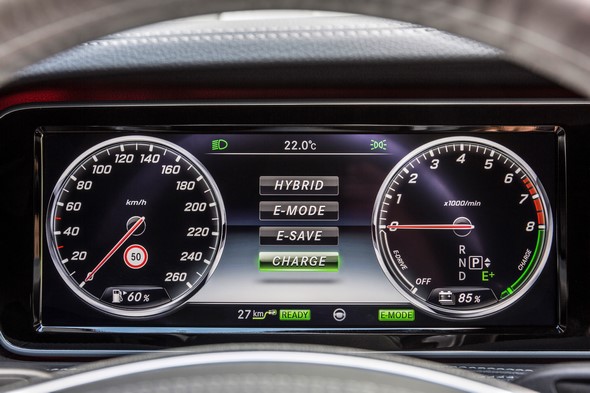
The dynamism and efficiency of the C 350 e make it a convincing proposition in both its saloon and estate variants.
With an all-electric range of up to 31 kilometres, local emission-free driving is now a reality. Its four-cylinder petrol engine, in conjunction with a powerful electric motor, gives it a total system output of 205 kW (279 hp) with a system torque of 600 Nm.
The new C 350 e thus delivers the performance of a sports car while offering a certified consumption of just 2.1 litres of fuel per 100 kilometres in both its saloon and estate variants.
This corresponds to CO2 emissions of 48 grams (49 grams for the estate) per kilometre.
Both models are also equipped as standard with AIRMATIC air suspension plus a pre-entry climate control system that can be controlled via the internet, adding up to a truly exceptional level of driving and climate comfort.
The C 350 e is available at dealerships from March 2015.
Following the C 300 BlueTEC HYBRID, the C 350 e is the second hybrid model in the new C-Class and the second Mercedes-Benz model to feature plug-in hybrid technology.
Thanks to their combination of internal combustion engine and electric motor, hybrid drives stand out with their low consumption and high performance.
The electric motor can replace or support the combustion engine and makes use of energy generated while braking by converting it into useful electric energy, which is stored and reused.
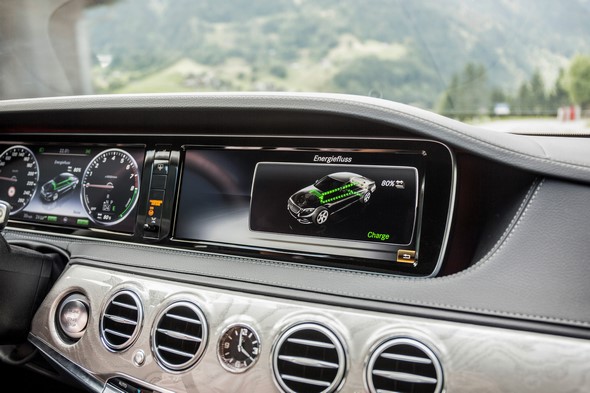
The C 350 e employs the currently most advanced hybrid technology. Its electrical energy storage unit is a high-voltage lithium-ion battery with a total capacity of 6.38 kWh, which can be charged from an external power source to make an effective contribution to the low consumption and emission figures.
The battery is water-cooled, weighs around 100 kilograms and is mounted in a sheet steel housing underneath the rear axle in order to maximise crash safety, driving dynamics and boot space.
Thanks to an intelligent on-board charging system, the battery can be recharged in around 1 hour 30 minutes at a wallbox or at one of the growing number of public charging points (230 V, 16 A, 3.7 kW single-phase), which in some cases offer privileged parking.
Alternatively, charging via a domestic power socket is, of course, also possible. Depending on the connection, a charge time of around two hours is achievable (with 230 V and 13 A, 3.0 kW, single-phase).
Despite the space taken up by the battery, the C 350 e still has a boot capacity of 335 litres in its saloon format and 350 litres in the estate model or, in the latter case, 1370 litres with the rear-seat backrests folded down and, as ever, a level load compartment floor.
Plug-in hybrid for the first time now with four-cylinder petrol engine
In the new Mercedes-Benz C 350 e, this hybrid drive concept is combined for the first time with an efficient four-cylinder petrol engine.
From a displacement of just under two litres, it produces 155 kW (211 hp) with a maximum torque of 350 Newton metres.
Its direct injection system with spray-guided combustion uses electronically precision-controlled multiple injection and fast multi-spark ignition to deliver outstanding performance coupled with high efficiency and exemplary emissions.
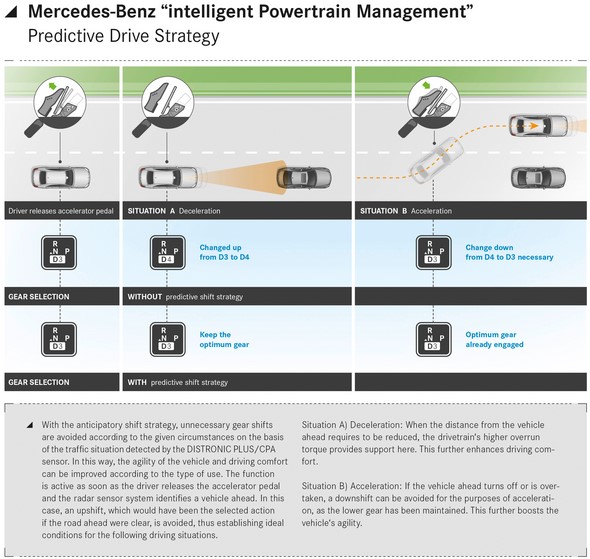
The electric motor in the C 350 e has an output of up to 60 kW and delivers a torque of 340 Newton metres, making for a total system output of 205 kW (279 hp) with a torque of 600 Newton metres.
7-speed automatic with additional clutch
The hybrid module of the standard 7-speed 7G-TRONIC PLUS automatic transmission incorporates both the electric motor and an additional clutch between the combustion engine and the electric motor.
When driving in all-electric mode, this decouples the combustion engine from the drive train.
It also, however, offers the possibility of moving off using the combustion engine but with the performance of a wet start-up clutch. The clutch here is a substitute for the torque converter.
The performance of a sports car
The high system output as well as intelligent drive management ensure the driving dynamics of a fleet-footed sports car, combined with the ride comfort of a premium saloon, along with fuel consumption and environmental compatibility on a level that, until recently, would not even have been expected of a small car.
The saloon can accelerate from zero to 100 km/h in 5.9 seconds, while the estate, at 6.2 seconds, is almost as quick off the mark.
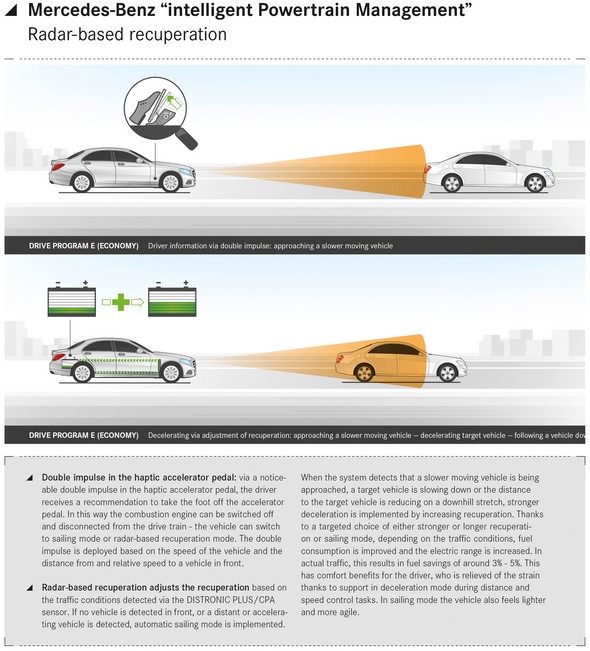
The saloon can reach a top speed of 250 km/h and the estate up to 246 km/h, both in conjunction with a certified fuel consumption of 2.1 litres per 100 kilometres.
This corresponds to CO2 emissions of 48 grams per kilometre (49 grams per kilometre for the estate).
Both variants of the C 350 e also offer the possibility of driving up to 31 kilometres in all-electric mode, thus completely free of CO2 local emissions – for example in the city.
A hybrid is efficient and dynamic to drive
The C 350 e offers all the characteristics of a state-of-the-art hybrid vehicle. These include first and foremost:
- Silent start: the vehicle starts virtually silently and runs in electric mode. At this point the combustion engine is generally kept switched off. Electric output of up to 60 kW is available for driving in all-electric mode.
- Boost: the electric motor kicks in to boost the output of the combustion engine by a further 60 kW – for example for rapid acceleration.
- Energy recuperation: during braking and coasting, energy is recovered and stored in the battery. This energy is then available later for electric driving or as a power boost.
Making by braking
The greatest potential for lowering the energy consumption of hybrid drive systems lies in maximising energy recovery on the overrun and during braking.
When the brake pedal is depressed, therefore, the electric motor initially takes on the task of decelerating, acting as an alternator.
If harder braking is required, the disk brakes will then intervene mechanically to provide additional grip.
This overlap between conventional mechanical braking and the electric braking performance of the electric motor in alternator mode increases the efficiency while remaining imperceptible.
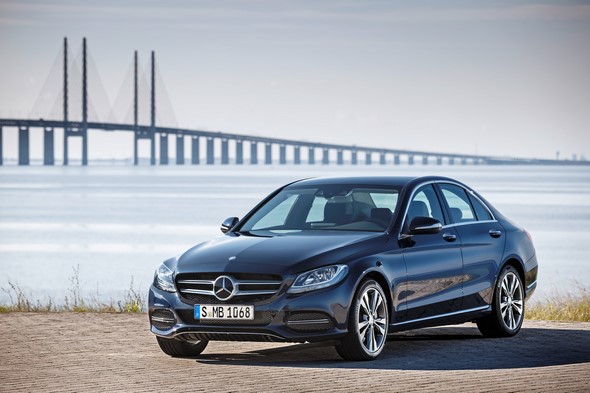
Working in the background, the intelligent drive management system in the C 350 e also automatically selects the ideal combination of combustion engine and electric motor.
Impulses for the driver
An innovation in the C 350 e is the so-called haptic accelerator pedal, which helps to reduce fuel consumption and therefore also exhaust emissions. It provides two types of information:
- If, when driving in electric mode, the driver’s foot meets a point of resistance on the accelerator pedal, this is an indication that maximum electric performance is being delivered. If the driver continues to depress the accelerator beyond this resistance point, the combustion engine will kick in.
- A double impulse from the ECO Assist function signals that the driver should remove their foot from the accelerator pedal in order to switch off the combustion engine and decouple it from the drive train. Assuming that the driver does what the double impulse suggests, the intelligent drive management system in the C 350 e varies how the vehicle behaves on the overrun between unpowered (coasting) and energy recovery, using data from the car’s radar systems as a basis.
Individual transmission mode
The complex technology of the C 350 e makes it no more difficult to drive than a conventional vehicle with automatic transmission.
But anyone wanting to can also intervene manually and regulate the hybrid interplay themselves, with the help of five operating modes and three transmission modes.
This is done via an operating mode switch and a transmission mode switch located in the centre console. A display in the middle of the instrument cluster shows the current setting.
Selecting a specific transmission mode enables the driver to define certain functions that influence the driving experience.
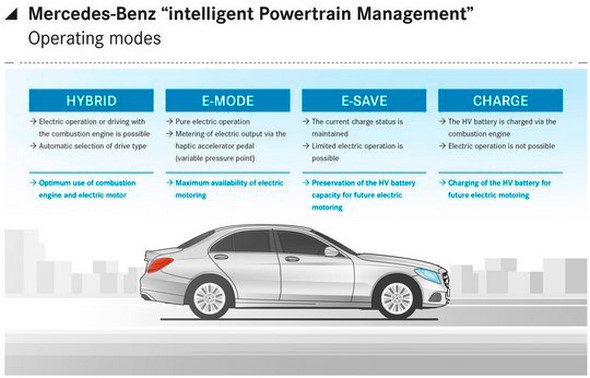
The following transmission modes are available:
- I Individual: individual definition of the characteristics of the transmission mode, including: drive, suspension, steering, ECO Assist, air conditioning
- S+ Sport+: maximum boost power, very sporty gear changes, the combustion engine is always active, particularly stiff suspension and damping settings.
- S Sport: enhanced boost power, sporty gear changes, the combustion engine is always active, stiff suspension and damping settings.
- C Comfort: boost power and energy recovery optimised for comfort and consumption, electric drive/ engine shut-off possible up to 130 km/h, comfort-oriented standard settings.
- E Economy: boost power is consumption-optimised, energy recovery minimised in favour of the coasting distance. All-electric mode and engine shut-off are possible. If the navigation system’s route guidance function is switched on and the Hybrid operating mode selected, the system will control the charge status of the high-voltage battery according to the route, ensuring that the electric operating mode is used as far as possible in built-up areas. The ECO Assist is also active.
ECO Assist activates an additional function, using the radar technology behind the standard proximity warning system in order to do so.
If the radar system identifies a slower-moving vehicle ahead, it sends a double impulse through the “haptic accelerator pedal” to signal to the driver to take their foot off the accelerator.
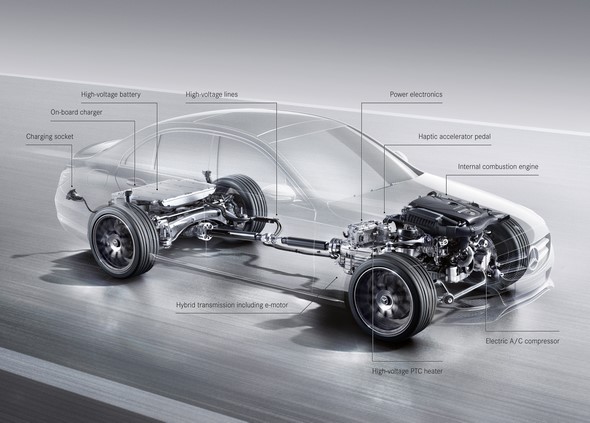
The vehicle will then adjust its deceleration automatically, using the electric motor to do so. In this way frequent braking, particularly in stop-and-go traffic, can be avoided.
Choice of four operating modes
In addition to selecting a transmission mode, the driver of the C 350 e can also use the operating mode switch to influence the regulation between electric mode and use of the engine for driving. In the Eco and Comfort transmission modes, the following operating modes are available:
- Hybrid: all hybrid functions such as electric operating mode, boost and recuperation are available and are applied according to the driving situation and route in the most fuel-efficient manner.
- E-mode: used for all-electric driving – for example in inner-city areas or because the battery holds sufficient charge for the remainder of the journey.
- E-save: the charge status of the battery is maintained – for example to allow all-electric driving in an environmental zone at a later stage in the journey. Electric driving and the boost function are therefore only available to a limited extent.
- Charge: allows the battery to be recharged while driving using the combustion engine – for example in order to ensure a higher state of battery charge for later parts of the journey. The combustion engine remains switched on and fuel consumption may increase. Electric operation is not possible.
In transmission modes S+ and S, the “Hybrid” operating mode is activated. In the “Individual” mode, the choice of available operating modes depends upon the drive system setting.
Route-based operating strategy
The best strategy for efficient operation is anticipatory driving. If the exact destination is known because the relevant data has been entered into the navigation system, charging and discharging of the high-voltage battery in the C 350 e are controlled to ensure the optimal use of energy on the overall route.
Another key point is the requirement that urban areas should be reached with a fully charged battery if possible, so that the vehicle can be driven efficiently in stop-and-go traffic – and frequently in electric mode.
Air suspension and pre-entry climate control as standard
The new C 350 e offers the familiar range of equipment and appointment options that are available for the C-Class and, in addition, includes the enhanced comfort feature AIRMATIC air suspension as part of its standard specification, along with a further comprehensive range of pre-entry climate control options.
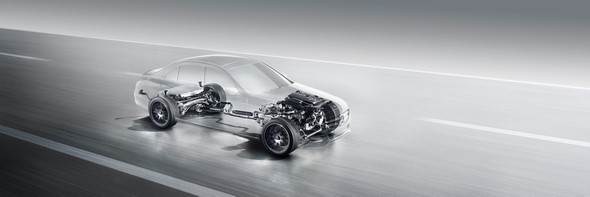
Thanks to its electronically regulated continuously variable damper adjustment at both front and rear axle, the air suspension offers outstanding ride comfort with minimal road roar and tyre vibration even when the vehicle is loaded, as well as self-levelling suspension all round.
Pre-entry climate control, a further standard feature, makes it possible to set the desired temperature for the interior of the vehicle before setting off – cooling it in the summer, warming it up in the winter. This can be activated by pre-setting the departure time (can be set in the vehicle or from home via the internet at http://connect.mercedes.me) or directly by pressing a button. This is possible due to the electrically powered refrigerant compressor and electric heating elements for the warm air circulation. In vehicles with the appropriate specification, the seat ventilation or heating will also be activated.
As well as the pre-entry climate control function, the charging of the vehicle can also be controlled via http://connect.mercedes.me. It is also possible to check the charge status of the high-voltage battery or the vehicle’s potential range in electric mode.
Two different faces for the plug-in hybrid as well
The C 350 e is available in the AVANTGARDE exterior equipment line, which emphasises its sporty, premium-vehicle character. As an alternative and at no extra cost, both the saloon and estate versions are also available in the EXCLUSIVE exterior equipment line. With its classic radiator grille and three-pointed star on the bonnet, the C-Class conveys a prestige status and sense of modern luxury.
The Mercedes-Benz designers have styled the interior on a level which is rarely encountered even in higher vehicle categories. This is evident from the carefully chosen high-class materials and their pleasant touch and feel as well as from the precision of the finely crafted details. Prominently located immediately above the centre console is a centrally positioned free-standing central display unit. All the functions of the head unit can be intuitively controlled from a touchpad using simple finger movements. Also available: a head-up display that projects important information onto the windscreen directly in the driver’s field of vision.
The C 350 e comes with H7 halogen headlamps as standard. In addition to the standard-fit headlamps, two energy-saving LED variants are available: a static system and a dynamic version with the “LED Intelligent Light System”.
Assistance systems for added safety and comfort
Both the saloon and estate variants of the C 350 e offer the same extensive range of safety and assistance systems as all other C-Class models. Two of the systems fitted as standard are ATTENTION ASSIST, which can warn of inattentiveness and fatigue, and COLLISION PREVENTION ASSIST PLUS, which protects against collision at speeds of over 7 km/h and, if the danger remains and the driver fails to react, can also undertake autonomous braking at speeds of up to 200 km/h and by so doing reduce the severity of an accident involving a slower-moving vehicle. Further systems from the new S and E-Class, either new or with significantly enhanced functions, are also available as options.
Vibrant infotainment experience
Even the basic version of the sophisticated multimedia system in the C-Class has internet capability if paired with a Bluetooth®-enabled mobile phone with data option. This enables the internet to be surfed without restrictions when the vehicle is stationary. Also standard is a basic telephony feature, which connects the mobile phone with the vehicle via a standardised Bluetooth® interface.
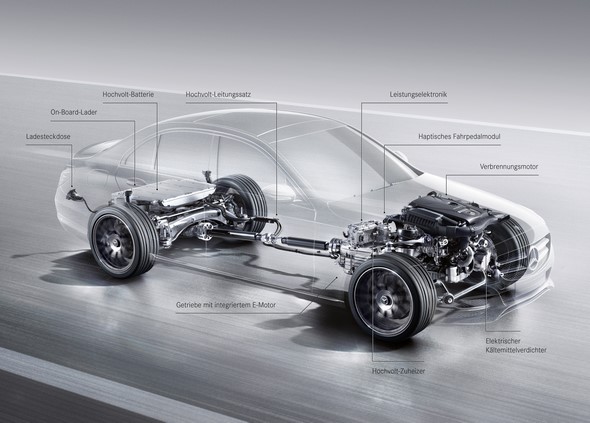
The Mercedes-Benz S 500 PLUG-IN HYBRID
Efficiency = Performance
The Mercedes-Benz S 500 PLUG-IN HYBRID combines an ultramodern hybrid drive concept with the unique innovations and luxurious equipment and appointments of the S-Class. This long-wheelbase luxury saloon impresses with its exceptional dynamism and efficiency. Thanks to the standard-specification pre-entry climate control system it also offers outstanding climate comfort. The first certified three-litre luxury saloon in the world is a further milestone on the road to emission-free mobility. The S 500 PLUG-IN HYBRID has been available since September 2014.
The Mercedes-Benz S 500 PLUG-IN HYBRID offers a system output of 325 kW with 650 Nm of torque, accelerates from 0 to 100 km/h in 5.2 seconds and has an all-electric range of up to 33 km. The certified consumption is 2.8 litres/100 km, which corresponds to 65 g CO2/km emissions. Key elements of this impressive output are the V6 biturbo and the intelligent hybrid drive.
Following the S 400 HYBRID and S 300 BlueTEC HYBRID, the S 500 PLUG-IN HYBRID is the third hybrid model in the new S-Class. Its new high-voltage lithium-ion battery with an energy content of 8.7 kWh can be externally recharged via the charging socket in the right side of the rear bumper.
The hybrid transmission is based on the 7G-TRONIC PLUS 7-speed automatic transmission. The plug-in-hybrid system in the S-Class is based on the
Mercedes-Benz parallel hybrid modular system. The common system-specific feature is the additional clutch integrated between the combustion engine and the electric motor. On the one hand this decouples the combustion engine during purely electric operation, while on the other it allows the vehicle to use the combustion engine to move off, drawing on the performance of a wet start-up clutch. The clutch here is a substitute for the torque converter and requires no additional space owing to its complete integration in the torque converter housing.
In order to strengthen customers’ trust in the new, innovative plug-in drive technology, for the S 500 PLUG-IN HYBRID Mercedes-Benz is for the first time issuing a certificate which provides an undertaking regarding the performance characteristics of the high-voltage battery and PLUG-IN HYBRID components
(e.g. electric motor and power electronics). This ensures that every technical malfunction within a period of six years after initial delivery or registration, or up to a mileage of 100,000 kilometres, is corrected by Mercedes-Benz.
Haptic accelerator pedal: support for the driver
Climb in, start the engine, drive off and, as well as exemplary efficiency, you can if you so wish experience via kickdown the special acceleration of the electric motor – this is how easy hybrid driving with the new S 500 PLUG-IN HYBRID is. Indeed, in everyday use it is just as straightforward to drive as any other vehicle with automatic transmission.
The intelligent operating strategy works automatically in the background to select the ideal combination of internal combustion engine and electric motor, thereby not only adapting its strategy to the load status of the battery but also anticipating the traffic situation or the route. But anyone wanting to can also intervene manually and regulate the hybrid interplay themselves, with the help of four operating modes and three transmission modes.
The haptic accelerator pedal, as it is known, can signal via a double impulse when the driver should take their foot off the accelerator for the purpose of sailing and recuperation. During electric operation it can supply the driver with feedback on the switch-on point of the combustion engine. The energy flow is shown in all operating states in the instrument cluster and in the central display, if this is selected by the customer.
Extensive standard equipment, extended pre-entry climate control
The standard equipment in the S 500 PLUG-IN HYBRID is extensive and offers a world premiere: extended pre-entry climate control. This is target value controlled. In other words: the S-Class is air-conditioned to the preset temperature ready for the start of the trip, assuming the driver has entered the departure time, for example via Mercedes connect me. This is possible due to the electrically driven refrigerant compressor and electric heating elements for the heated air. In addition to this, when preheating it is not just the interior air but also the seats, steering wheel and armrests in the doors and centre console that are heated, and when cooling the seat ventilation is also activated if the respective optional extra is on board.
Also standard in the S 500 PLUG-IN HYBRID, which is available only with a long wheelbase, are for example LED High Performance headlamps and LED tail lights, leather upholstery, COMAND Online, touchpad, THERMOTRONIC automatic climate control plus seat heating also in the rear, Memory package for driver and front passenger, ambient lighting in seven colours and the AIRMATIC air suspension system with continuously variable damping control. The basic safety equipment includes PRE-SAFE®, COLLISION PREVENTION ASSIST PLUS (collision warning including Adaptive Brake Assist), ATTENTION ASSIST, PRE-SAFE® impulse, Crosswind Assist and Traffic Sign Assist (traffic sign recognition incl. wrong-way warning function and display of speed limits in the instrument cluster). Over and above this a multitude of unique optional extras is available.
The Mercedes-Benz hybrid strategy: emphasis on plug-in drive systems
Hybrid drive systems, the combination of internal combustion engine and electric drive, help cut overall fuel consumption and boost performance, since the electric drive system replaces or supports the combustion engine – normally at part load when little power is required.
The greatest potential for lowering the energy consumption of hybrid drive systems lies in maximising energy recovery on overrun and during braking. When the brake pedal is depressed, deceleration is initially effected by the electric motor and not by the disc brakes. The hybrid models of the new S-Class are the first to use a regenerative braking system of the second generation. This ensures the imperceptible overlapping of the conventional mechanical brakes and the electric braking performance of the electric motor in generator mode.
Intelligent operating strategy
For efficient motoring, foresighted driving that avoids unnecessary braking or accelerating manoeuvres has always been the best strategy. This gains an all new importance in a hybrid model: because braking manoeuvres serve not only to deliver deceleration, but can also be used to recover energy. The route, too, has considerable influence on the most efficient charging and discharging of the high-voltage battery.
The intelligent operating strategy supports the driver comprehensively yet unobtrusively to achieve the most efficient driving style. The control strategy, for example, seeks to ensure that the battery, if at all possible, is flat at the end of an uphill stretch so that it can be recharged going downhill. Another key point is the requirement that urban areas should be reached with a fully charged battery if possible, so that the vehicle can be driven efficiently in stop-and-go traffic – and frequently in electric mode.
In the S 500 PLUG-IN HYBRID the energy management system basically covers these three areas:
- route-based: automatically or by way of four operating modes
- driver-based: by way of three transmission modes
- traffic-based: with the aid of radar
Charging: power from a socket
The battery in the S 500 PLUG-IN HYBRID is safely fitted into the rear end of the S-Class to save space.
An intelligent on-board charging system enables the battery to be charged at any conventional domestic power socket. The supply of electricity to the car will be made even easier in future through inductive, cableless charging.
The S 500 PLUG-IN HYBRID stores electric energy in a lithium-ion battery on lithium-iron phosphate basis. The water-cooled energy storage unit has an overall capacity of 8.7 kWh, a total weight of 114 kg and a spatial volume of 96 litres.
To ensure highest levels of crash safety and dynamic handling as well as maximum boot space, the housing is made of die-cast aluminium, while the high-voltage battery is located in the rear of the vehicle above the rear axle.
The space available there is put to optimal use, and the S 500 PLUG-IN HYBRID thus takes first place among the plug-in hybrids in terms of boot capacity (395 litres) and luggage compartment accessibility.
The high-voltage battery of the S 500 PLUG-IN HYBRID can be charged via external mains electricity using a 3.6 kW on-board charger.
The unit is permanently installed in the vehicle and charges single-phase up to 16 A. The connection point for the charging cable is located behind a flap in the rear bumper, underneath the right-hand tail light.
An automatic lock ensures that the charging cable cannot be disconnected from the vehicle by unauthorised persons.
The new S-Class can be charged in two hours anywhere in the world, e.g. at a wallbox or charging station (400 V, 16 A). Alternatively, charging via a standard domestic connection is of course also possible.
Depending on the connection, a charge time of e.g. two hours and 45 minutes is possible (at 230 V and 13 A)[1].
Next step: S 500 PLUG-IN HYBRID – unplugged
One of the next steps on the road to the perfect electric vehicle and plug-in hybrid is cableless charging. Inductive battery charging will make the handling of electric vehicles and plug-in hybrids even more convenient.
Mercedes-Benz will test this “unplugged” technology with the S 500 PLUG-IN HYBRID in order to develop a genuine S-Class solution, in terms of comfort and ease of operation, for the charging of the high-voltage battery.
[1] The charge time ranges between 2 hours (400 V/16 A, e.g. at a wallbox) and 4.1 hours (230 V/ 8 A, e.g. at a household power outlet).
Through settings on the control element of the charging cable, shorter charge times can be realised even at domestic sockets, provided that the power supply system is designed for this.
The voltage and current ratings indicated refer to the power supply infrastructure and can be limited by the car. All charge times refer to the charging of the battery from 20% to 100%.



